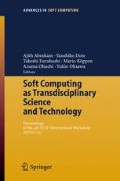Abstract
Peptides binding to MHC molecules can be presented to T-cell receptor and then trigger an immune response. Prediction of peptides binding a specific major histocompatibility complex has great significance for immunology research and vaccine design. According to their different structures and functions, MHC molecules can be classified into two types. Most of early studies often focus on MHC class I, but seldom on MHC class II. In this paper, we present a method for MHC class II binding peptides prediction using Fourier analysis and support vector machines (SVM), the novel prediction technique is found to be comparable with the best software currently available.
Access this chapter
Tax calculation will be finalised at checkout
Purchases are for personal use only
Preview
Unable to display preview. Download preview PDF.
References
Brusic V, Rudy G, Harrison LC (1998b) MHCPEP, a database of MHC-binding peptides: update 1997. Nucleic Acids Res 26:368–371
Brusic V, Rudy G, Honeyman G, Hammer J, Harrison LC (1998a) Prediction of MHC class II-binding peptides using an evolutionary algorithm and artificial neural network. Bioinformatics 14:121–130
Buus S, Lauemøller SL, Worning P, Kesmir C, Frimurer T, Corbet S, Fomsgaard A, Hilden J, Holm A, Brunak S (2003) Sensitive quantitative predictions of peptide-MHC binding by a ‘Query by Committee’ artificial neural network approach. Tissue Antigens 62: 378–384
Castellino F, Zhong G, Germain RN (1997) Antigen presentation by MHC class II molecules: invariant chain function, protein trafficking, and the molecular basis of diverse determinant capture. Hum Immunol 54: 159–169
Ding CH, Dubchak I (2001) Multi-class protein fold recognition using support vector machines and neural networks. Bioinformatics 17: 349–358
Hua SJ, Sun ZR (2001) A novel method of protein secondary structure prediction with high segment overlap measure: support vector machine approach. Journal of Molecular Biology 308: 397–407
Lawrence CE, Altschul SF, Boguski MS, Liu JS, Neuwald AF, Wootton JC (1993) Detecting subtle sequence signals: a Gibbs sampling strategy for multiple alignment. Science 262: 208–214
Marshall KW, Wilson KJ, Liang J, Woods A, Zaller D, Rothbard JB (1995) Prediction of peptide affinity to HLA DRB1*0401. J Immunol 154:5927–5933
Matthew ND, Clare ES, Claude B, David SM (2003) A novel predictive technique for the MHC class II peptide-binding interaction. Molecular crystallography 9: 9–12
Metropolis N, Rosenbluth AW, Teller AH, Teller E (1953) Equation of state calculation by fast computing machines. J Chem Phys 21:1087–1092
Nielsen M, Lundegaard C, Worning P, Lauemoller SL, Lamberth K, Buus, S., Lund O (2003) Reliable prediction of T-cell epitopes using neural networks with novel sequence representation. Protein Sci 12:1007–1017
Nielsen M, Lundegaard C, Worning P, Hvid CS, Lamberth K, Buus S, Brunak S, Lund O (2004) Improved prediction of MHC class I and class II epitopes using a novel Gibbs sampling approach. Bioinformatics 20:1388–1397
Rammensee H, Bachmann J, Emmerich NP, Bachor OA, Stevanovic S (1999) SYFPEITHI: database for MHC ligands and peptide motifs. Immunogenetics 50: 213–219
Shepherd AJ, Gorse D, Thornton JM (2003) A novel approach to the recognition of protein architecture from sequence using Fourier analysis and neural networks. Proteins: Structure, Function, and Genetics 50: 290–302
Sturniolo T, Bono E, Ding J, Raddrizzani L, Tuereci O, Sahin U, Braxenthaler M, Gallazzi F, Protti MP, Sinigaglia F, Hammer J (1999) Generation of tissue-specific and promiscuous HLA ligand databases using DNA microarrays and virtual HLA class II matrices. Nat Biotechnol 17: 555–561
Trad CH, Fang Q, Cosic I (2000) The resonant recognition model (RRM) predicts amino acid residues in highly conserved region of the hormose prolactin (PRL). Biophysical Chemistry 84: 144–157
Vapnik V (1998). Statistical Learning Theory. Wiley-Interscience, New York
Yan M, Lin ZS, Zhang CT (1988) A new Fourier transform approach for protein coding measure based on the format of the Z curve. Bioinformatics 14:685–690
Yu K, Petrovsky N, Schonbach C, Koh JY, Brusic V (2002) Methods for prediction of peptide binding to MHC molecules: a comparative study. Mol Med 8: 137–148
Zhang SW, Pan Q, Zhang HC, Zhang YL, Wang HY (2003) Classification of protein quaternary structure with support vector machine. Bioinformatics 19:2390–2396
Zhao YD, Pinilla C, Valmori D, Martin R, Simon R (2003) Application of Support vector machines for T-cell epitopes prediction. Bioinformatics 19: 1978–1984
Author information
Authors and Affiliations
Editor information
Editors and Affiliations
Rights and permissions
Copyright information
© 2005 Springer-Verlag Berlin Heidelberg
About this paper
Cite this paper
Huang, J., Shi, F. (2005). Prediction of MHC class II Epitopes Using Fourier Analysis and Support Vector Machines. In: Abraham, A., Dote, Y., Furuhashi, T., Köppen, M., Ohuchi, A., Ohsawa, Y. (eds) Soft Computing as Transdisciplinary Science and Technology. Advances in Soft Computing, vol 29. Springer, Berlin, Heidelberg. https://doi.org/10.1007/3-540-32391-0_10
Download citation
DOI: https://doi.org/10.1007/3-540-32391-0_10
Publisher Name: Springer, Berlin, Heidelberg
Print ISBN: 978-3-540-25055-5
Online ISBN: 978-3-540-32391-4
eBook Packages: EngineeringEngineering (R0)

